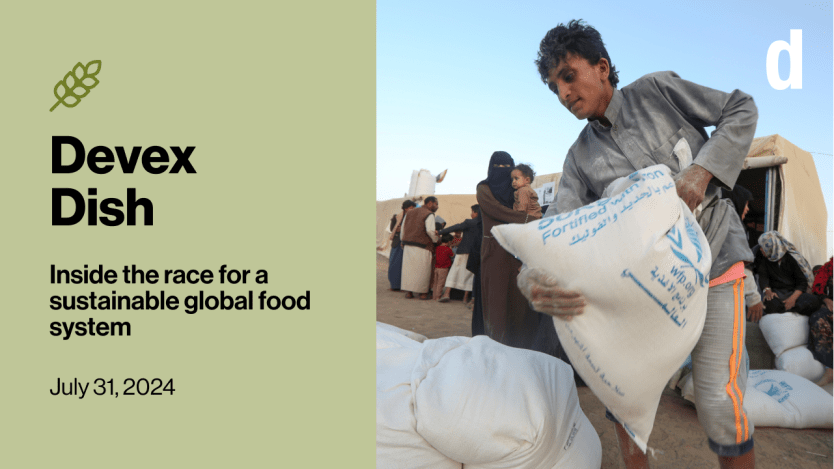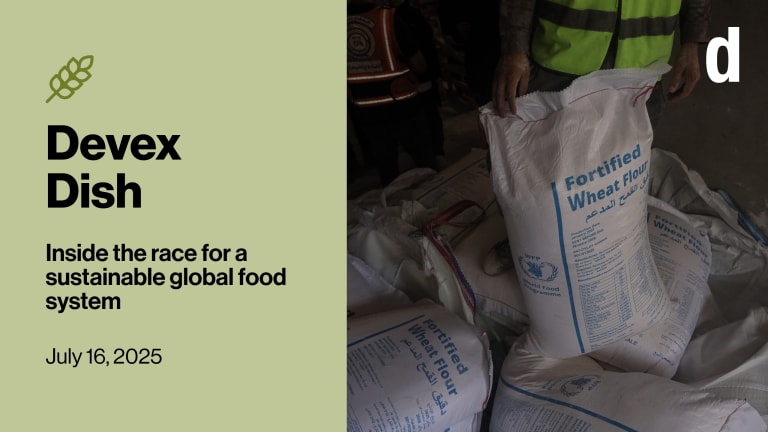
The United States has agreed in principle to resume food aid to Yemeni citizens living in northern areas controlled by Houthi rebels, ending a yearlong diplomatic standoff, Devex’s Colum Lynch exclusively reports.
A suspension will technically still remain in place, but the move should pave the way for the World Food Programme, which receives most of its financial support from the U.S., to launch a rapid emergency response operation that will feed more than 1 million people as early as next month, diplomatic sources tell Colum.
The Biden administration first suspended food aid to northern Yemen last August after Iranian-backed insurgents detained United Nations aid workers and attacked international merchant ships on the Red Sea, including some belonging to the U.S.
This is a preview of Devex Dish
Sign up to this weekly newsletter to get the inside track on how agriculture, nutrition, sustainability, and more are intersecting to remake the global food system.
An additional aim of the suspension was to give WFP some leverage in its efforts to redirect food assistance. The agency was facing a funding shortfall and — in order to ensure the survival of those facing the most severe levels of acute hunger — sought to drop its support from 9.5 million civilians in northern Yemen to 6.6 million, while increasing the size of the daily rations.
After the Houthis rejected this plan, WFP suspended its general food distribution program in northern Yemen in December.
WFP has concluded that the Houthis are now willing to cooperate, at least enough to resume some targeted food aid operations. And U.S. officials have signaled that they are ready to release tens of thousands of tons of wheat they have been storing in the United Arab Emirates. They just await a formal request from WFP before doing so.
But not everyone is on board with the plan, Colum reports. In recent months, the Houthis have attacked commercial vessels in the Red Sea and detained dozens of international aid workers and diplomats. At the same time, regional conflicts are impacting Yemen, with Israeli fighters striking a Houthi-controlled port earlier this month.
That has led some aid workers to question whether it is safe to resume aid — national staff are “terrified” — and whether the Houthis have actually demonstrated a willingness to cooperate. WFP declined to comment.
Read: US to restart aid to Houthi territory
ICYMI: ‘Blackmail/dragnet’ ensnares UN aid workers in Yemen
Background reading: US halts some Yemen aid, plays diplomatic hardball with Houthis
A hot lunch
A two-year conflict, COVID-19, and drought in the Ethiopian region of Tigray forced persistent school closures and ultimately drove more than half of the area’s students from class. School feeding programs are slowly bringing them back.
Even though the affordable solution has proven effective at drawing students back to school, it earns little support from nongovernmental organizations or donors. Only about 150,600 children in Tigray are currently receiving school meals, comprising just over 6% of the total student population, according to the Tigray Education Bureau. Devex contributor Gabriella Jóźwiak traveled to the region to find out why the programs don’t bring in more support.
WFP officials explain that, in their case, Tigray is competing with other parts of the country for limited resources. Students in the country’s Amhara region have also been contending with conflict and persistently high rates of malnutrition, for instance. WFP simply doesn’t have enough to go around.
And major donors, such as USAID, do not currently support school feeding programs. Instead, the agency channels its money into emergency food assistance. But problems with “widespread and systematic food aid diversion across the country” led the agency to shut down food aid deliveries in May 2023, before resuming it toward the end of last year.
In this environment, the organizations that are actually providing school meals have learned to be flexible. Mary’s Meals International, or MMI, which works with the Daughters of Charity, or DOC, a local Catholic organization, started running a school feeding program in 2017.
When COVID-19 struck, the organizations sent the food as take-home rations. During the two-year conflict between Tigrayan forces and the Ethiopian government that began in 2020, food aid to the region was restricted. DOC pressed to channel the food originally designated for the schools to the displacement camps springing up across the region. They ended up feeding 30,000 internally displaced people for 10 months across 27 camps.
Now they are back in schools, feeding an estimated 114,600 students. It’s quite a jump from 24,000 students MMI and DOC fed when the program first started, but not nearly enough to meet the need across Tigray.
Read: School meals in Tigray are a lifeline. Why are so few offering them?
Also read: Sister-in-arms — Medhin Tesfay fights against hunger in Tigray
Not so fast
Meat and dairy companies are interested in giving the appearance of addressing climate change, it seems, but the reality is something different, according to a new report from the Changing Markets Foundation.
Digging into the activities of 22 of the biggest meat and dairy companies, the report — entitled The New Merchants of Doubt — details their efforts “to delay, distract, and derail action on transforming the food system.” That includes spending more money on advertising than on the low-carbon solutions that some companies claim will help reduce the industries’ greenhouse gas emissions.
Bringing home the bacon
Your next job?
Project Director, Anticipated DASHED FTF Activity
RTI International
United States
The problem, of course, is that the meat and dairy sector is responsible for more than 14% of global greenhouse gas emissions, and many experts believe that meeting the Paris Agreement’s target of 1.5 degrees Celsius temperature increase limit will mean bringing down the industries’ methane emissions and reducing animal product consumption.
To delay governments from demanding reductions, the industry has sought to stall by claiming they are already taking voluntary actions, according to the report. And they have also channeled substantial sums into political donations and directly and indirectly lobbying policymakers who might take their side in future debates.
The report also lays out interesting distraction tactics, including strategies aimed at younger consumers who are more prone to worry about climate change and health than older generations. The companies draw in social media influencers in efforts that seek, among other things, to present meat and dairy as healthier dietary choices than plant-based diets for young consumers.
Check out the report for the full arsenal of strategies.
Background reading: $205B a year could slash agri-food systems emissions by nearly half
Related: What the world can learn from Denmark’s carbon tax on agriculture (Pro)
+ Not yet a Devex Pro member? Access all our exclusive reporting and analyses, data-driven funding insights, members-only events, and the world’s largest global development job board by starting a 15-day free trial today.
Time out
Dish will be taking its annual summer hiatus, and will be back on Wednesday, Aug. 14. That means no edition of the newsletter next week, but we will be sending out deep dives on some of the most pressing development topics — including one on trends in climate-resilient agriculture. If you’d like to receive them, please sign up for the daily Newswire.
Chew on this
Sudan’s agriculture minister says there is no famine in the country and cast doubt on a recent U.N.-backed report showing that some 755,000 people are experiencing catastrophic hunger. [Reuters]
The Group of 20 leading economies plans to officially launch the Global Alliance Against Hunger and Poverty at a November meeting in Brazil. [G20 Brasil 2024]
To feed more than 15,000 athletes during the Olympics and Paralympics, a catering group is serving more than 500 different dishes, while working with the athletes to tailor the options specifically to their taste. [Eater]
A La Niña weather pattern that looks set to form later this year could undo some of the damage to agricultural systems done by the strongest El Niño in almost a decade. [Bloomberg]








